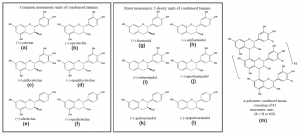Proanthocyanidins are structurally reasonably simple, but the tendency of plant cells to synthesize mixtures of oligomers and polymers makes their chemistry typically quite demanding

Fig. 1. Structures of the common (a–f) and more rare (g–l) monomeric building units of condensed tannins, and an example of the polymeric condensed tannins (m).
Proanthocyanidins (PAs) are the most common group of tannins and they typically consist of two or more monomeric (+)-catechin or (-)-epicatechin units (Fig. 1a–b). These types of PAs are called procyanidins (PCs), while the other common CT group, prodelphinidins (PDs), consist of (+)-gallocatechin or (-)-epigallocatechin units (Fig. 1c–d). Other types of common (Fig. 1e–f) or rarer (Fig. 1g–l) monomer units are shown in Figure 1. In plants, PAs are found as oligomers (two to ten monomer units) or polymers (>10 monomer units).
